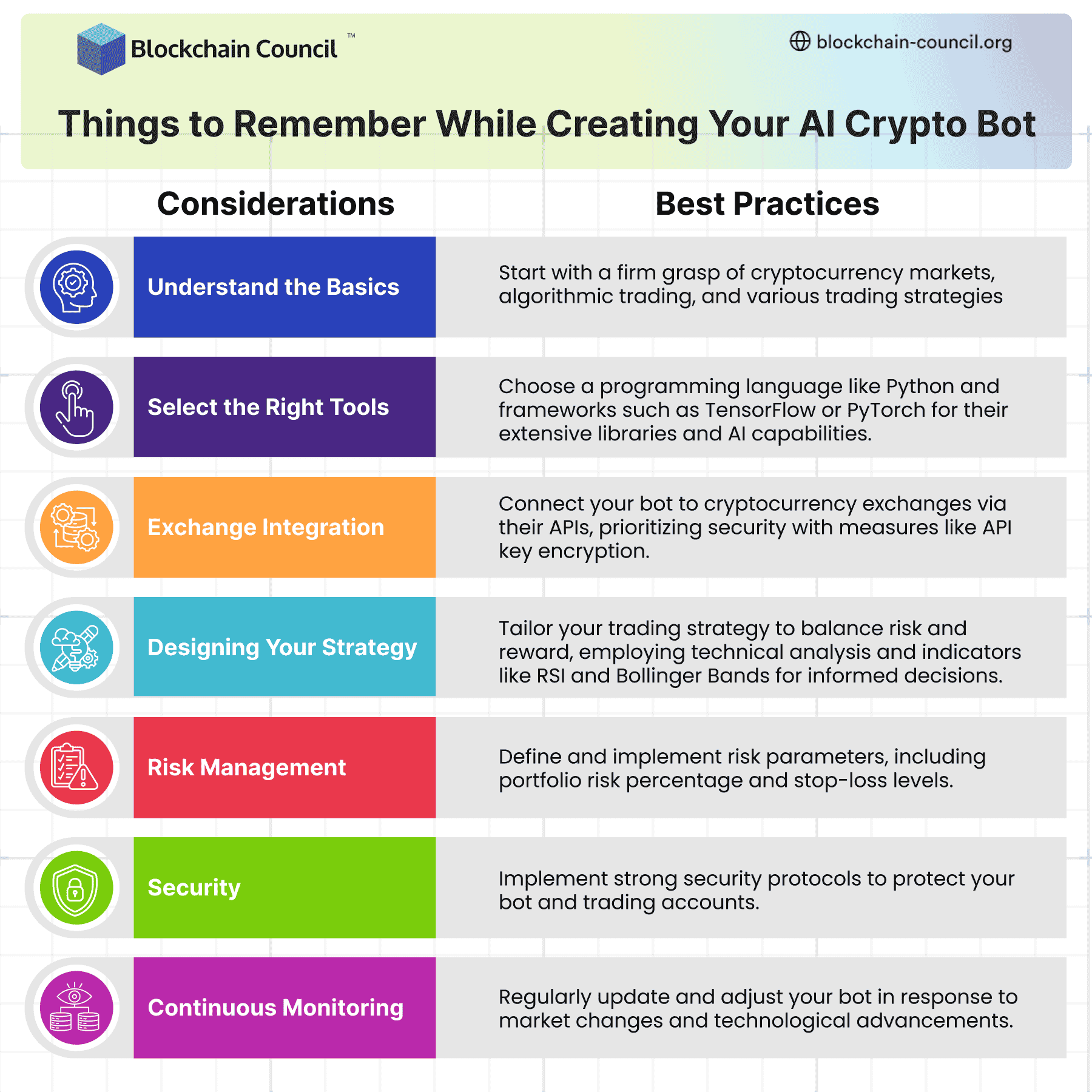
- Amber Smith
- January 09, 2025
Summary
- AI crypto trading bots leverage artificial intelligence to automate cryptocurrency trading, capitalizing on their ability to analyze data and execute trades 24/7 without emotional bias.
- This article provides a step-by-step guide for building your own AI crypto trading bot, covering crucial aspects such as programming language selection, API connection setup, and trading strategy design.
- Python is a popular choice for its ease of use and extensive library ecosystem, but other languages like JavaScript, C#, Rust, and Go offer unique advantages depending on project requirements.
- Setting up API connections with cryptocurrency exchanges like Binance is essential for data exchange and trade execution, requiring careful handling of API keys for security.
- Designing a trading strategy tailored to your goals, whether trend following, arbitrage, or market making, influences the complexity and effectiveness of your bot.
- Coding the bot involves integrating APIs, implementing the chosen strategy, and thorough testing to ensure functionality before deployment.
- Testing and backtesting are critical to verifying the bot’s performance under real-world and historical market conditions, aiding in strategy refinement.
- Deploying the bot on cloud infrastructure ensures continuous operation, with AWS, Google Cloud, or Azure being popular choices for scalability and reliability.
- Continuous monitoring and optimization are necessary post-deployment, with tools like TradingView charts and indicators assisting in decision-making.
- While AI bots offer advantages, traders must remain cautious due to market volatility and inherent risks.
The world of cryptocurrency trading is evolving at an unprecedented pace, thanks in large part to advancements in artificial intelligence (AI). In recent years, the use of AI trading bots has surged, driven by their ability to operate 24/7, their resilience to emotional trading, and their capacity to process and analyze data at a scale impossible for human traders. Ever wondered how you can build your own AI crypto trading bot?
This article guides you to the steps for building your own AI crypto trading bot. By the end of this article, you will gain insights into the tools, strategies, and considerations essential for successfully building and deploying your own AI crypto trading bot.
If you want to land a high-paying job in the field of cryptocurrencies then our crypto certifications like the Certified Cryptocurrency Trader™ and the Certified Cryptocurrency Expert™ (CCE) will make you stand out. And don’t forget to check out our latest offers to grab the one that suits your needs the best!
What are AI Crypto Trading Bots?
AI crypto trading bots are tools powered by artificial intelligence designed to automate the trading of cryptocurrencies. These bots are gaining popularity among traders due to their ability to analyze vast amounts of data rapidly, recognize patterns, and execute trades based on predefined criteria or self-learning algorithms. The integration of AI and machine learning models into crypto trading bots represents an advanced approach to cryptocurrency trading. These models can analyze historical data, learn from market patterns, and adapt their trading strategies based on new information. This dynamic adjustment process can significantly enhance trading performance by identifying profitable trading opportunities that human traders might miss.
Step-by-Step Guide to Building Your AI Crypto Trading Bot
Building an AI crypto trading bot is an exciting venture that combines finance with technology. Here are the critical steps you must follow to create a bot that can autonomously execute trades based on predefined criteria:
1. Choosing a Programming Language
When it comes to selecting the best programming language for your AI crypto trading bot, there are several key options, each with its pros and cons:
- Python: Known for its ease of use and readability, Python is a popular choice due to its vast library ecosystem, which is advantageous for data analysis and machine learning applications. However, it may have slower execution speeds and might not be ideal for memory-intensive tasks.
- JavaScript: This language is beneficial for bots that need to interact with web-based platforms, thanks to its asynchronous capabilities for handling multiple API requests. But, it might not be as effective for heavy computational tasks.
- C#: Offers high performance and efficient memory management, making it suitable for real-time data processing. The trade-off is a steeper learning curve and potentially longer development times.
- Rust and Go (Golang): Both are notable for their high performance, with Rust offering memory safety features and Go providing strong concurrency support. Each has its unique advantages, depending on your specific needs.
Choosing the right language depends on your project’s requirements, your familiarity with the language, and the specific features you need for your trading bot.
2. Setting Up an API Connection
After choosing a programming language, the next step is to establish a connection to cryptocurrency exchanges through their APIs. APIs (Application Programming Interfaces) are crucial for your trading bot, allowing it to send and receive data from crypto exchanges. You need to create API keys on the exchanges you wish to trade on and configure your bot to use these keys. Be cautious with your API keys, especially concerning permissions related to withdrawals to ensure security. Here’s an example using the Binance API with the python-binance library:
from binance.client import Client
api_key = ‘your_api_key_here’
api_secret = ‘your_api_secret_here’
client = Client(api_key, api_secret)
# Get account information
account_info = client.get_account()
print(account_info)
You’ll need to replace ‘your_api_key_here’ and ‘your_api_secret_here’ with your actual Binance API key and secret.
3. Designing Your Trading Strategy
Your trading strategy is the heart of your bot. Some popular strategies include:
- Trend Following: The bot identifies and trades based on the direction of market trends.
- Arbitrage: Taking advantage of price differences between exchanges.
- Market Making: Continuously buying and selling to profit from the spread between buy and sell prices.
The choice of strategy will impact the complexity and design of your bot, so it’s crucial to select one that aligns with your trading goals and expertise.
4. Coding the Bot
After selecting your programming language and strategy, the next step is coding. This involves setting up your development environment, integrating APIs, implementing your trading strategy, and testing the bot thoroughly before deployment. If you’re using Python, for example, you’ll need to install necessary libraries and dependencies and may consider using an IDE like PyCharm for development. Combining the API connection with your strategy, here’s how you might code the bot’s main loop:
import time
symbol = ‘BTC/USDT’
while True:
if should_buy(symbol):
print(f”Buying {symbol}…”)
# Example: Place a market buy order
exchange.create_market_buy_order(symbol, amount)
elif should_sell(symbol):
print(f”Selling {symbol}…”)
# Example: Place a market sell order
exchange.create_market_sell_order(symbol, amount)
# Wait before checking again
time.sleep(60 * 5) # 5 minutes
5. Testing and Backtesting
- Testing Your Bot: To ensure your bot functions correctly in real-world trading conditions, testing is crucial. Using middleware like Alpha Shifter can bridge your strategy from TradingView to exchanges like Binance, allowing you to send custom signals directly to your exchange account. Before deploying with real funds, testing your bot using the Binance Testnet is advisable. This environment simulates real trading without the risk, though it’s important to remember testnet liquidity is limited and may not fully represent live market conditions.
- Backtesting: This involves running your bot against historical market data to evaluate its performance. Platforms like Bitsgap and Gainium offer tools for backtesting your strategies, allowing you to adjust your settings based on past performance to forecast future outcomes. These tools support various bot types and provide advanced metrics and visualizations to help refine your strategies.
6. Deploying on Cloud Infrastructure
Deploying your bot on a cloud platform like AWS, Google Cloud, or Azure ensures it runs 24/7, handling trading opportunities any time of the day without interruption. While specific steps can vary depending on the cloud provider, the general process involves setting up a virtual machine or container for your bot, configuring your trading strategies, and ensuring secure API connectivity to your preferred crypto exchanges. Consider cloud services that offer robust security features, scalability to handle different market conditions, and reliable uptime.
7. Optimization and Monitoring
Once your bot is live, continuous monitoring and optimization are key to maintaining its effectiveness. Regularly review its performance metrics, adjust strategies as market conditions change, and stay updated on cryptocurrency market trends. Tools like TradingView charts & indicators integrated into backtesting platforms can aid in technical analysis, helping you fine-tune your bot’s decision-making processes.
Things to Remember While Creating Your AI Crypto Bot
Conclusion
Building an AI crypto trading bot is an intricate but rewarding process that combines technology, financial insight, and strategic planning. By adhering to the outlined considerations and best practices, developers can create powerful tools that automate trading decisions, optimize strategies, and potentially enhance profitability in the crypto market.
While AI and machine learning offer significant advantages, it’s crucial for traders to remain cautious. The cryptocurrency market is highly volatile, and even the most sophisticated AI models cannot guarantee profits. It’s essential to understand the limitations and risks involved, including the potential for model overfitting and the impact of unforeseen market events.
FAQ’s
What is an AI crypto trading bot?
- An AI crypto trading bot is a tool powered by artificial intelligence designed to automate the trading of cryptocurrencies.
- These bots analyze vast amounts of data rapidly and execute trades based on predefined criteria or self-learning algorithms.
How do I build my own AI crypto trading bot?
- Choose a programming language like Python, JavaScript, C#, Rust, or Go, depending on your project’s requirements and your familiarity with the language.
- Set up API connections to cryptocurrency exchanges through their APIs, allowing your bot to send and receive data.
- Design a trading strategy that aligns with your goals and expertise, such as trend following, arbitrage, or market making.
- Code the bot by integrating APIs, implementing your trading strategy, and thoroughly testing it before deployment.
What are some popular trading strategies for AI crypto trading bots?
- Trend Following: Identifies and trades based on the direction of market trends.
- Arbitrage: Takes advantage of price differences between exchanges.
- Market Making: Continuously buys and sells to profit from the spread between buy and sell prices.
How can I ensure the security and effectiveness of my AI crypto trading bot?
- Implement strong security protocols, including encrypted API keys and secure API connections, to protect your bot and trading accounts.
- Regularly monitor and optimize your bot’s performance, adjusting strategies as market conditions change.
- Use backtesting tools to evaluate your bot’s performance against historical data and refine your strategies accordingly.
- Stay updated on cryptocurrency market trends and technological advancements to make informed decisions and maintain bot effectiveness.






































































 Guides
Guides News
News Blockchain
Blockchain Cryptocurrency
& Digital Assets
Cryptocurrency
& Digital Assets Web3
Web3 Metaverse & NFTs
Metaverse & NFTs
